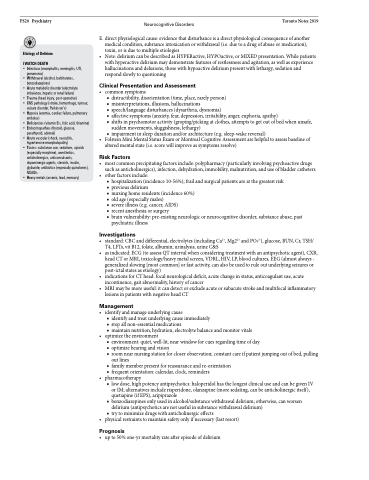Page 1184 - TNFlipTest
P. 1184
PS20 Psychiatry
Neurocognitive Disorders Toronto Notes 2019
E. direct physiological cause: evidence that disturbance is a direct physiological consequence of another medical condition, substance intoxication or withdrawal (i.e. due to a drug of abuse or medication), toxin, or is due to multiple etiologies
• Note: delirium can be described as HYPERactive, HYPOactive, or MIXED presentation. While patients with hyperactive delirium may demonstrate features of restlessness and agitation, as well as experience hallucinations and delusions, those with hypoactive delirium present with lethargy, sedation and respond slowly to questioning
Clinical Presentation and Assessment
• common symptoms
■ distractibility, disorientation (time, place, rarely person)
■ misinterpretations, illusions, hallucinations
■ speech/language disturbances (dysarthria, dysnomia)
■ affective symptoms (anxiety, fear, depression, irritability, anger, euphoria, apathy)
■ shifts in psychomotor activity (groping/picking at clothes, attempts to get out of bed when unsafe,
sudden movements, sluggishness, lethargy)
■ impairment in sleep duration and/or architecture (e.g. sleep-wake reversal)
• Folstein Mini Mental Status Exam or Montreal Cognitive Assessment are helpful to assess baseline of altered mental state (i.e. score will improve as symptoms resolve)
Risk Factors
• most common precipitating factors include: polypharmacy (particularly involving psychoactive drugs such as anticholinergics), infection, dehydration, immobility, malnutrition, and use of bladder catheters
• other factors include:
■ hospitalization (incidence 10-56%); frail and surgical patients are at the greatest risk
■ previous delirium
■ nursing home residents (incidence 60%)
■ old age (especially males)
■ severe illness (e.g. cancer, AIDS)
■ recent anesthesia or surgery
■ brain vulnerability: pre-existing neurologic or neurocognitive disorder, substance abuse, past
psychiatric illness
Investigations
• standard: CBC and differential, electrolytes (including Ca2+, Mg22+ and PO43-), glucose, BUN, Cr, TSH/ T4, LFTs, vit B12, folate, albumin; urinalysis, urine C&S
• as indicated: ECG (to assess QT interval when considering treatment with an antipsychotic agent), CXR, head CT or MRI, toxicology/heavy metal screen, VDRL, HIV, LP, blood cultures, EEG (almost always - generalized slowing [most common] or fast activity, can also be used to rule out underlying seizures or post-ictal states as etiology)
• indications for CT head: focal neurological deficit, acute change in status, anticoagulant use, acute incontinence, gait abnormality, history of cancer
• MRI may be more useful: it can detect or exclude acute or subacute stroke and multifocal inflammatory lesions in patients with negative head CT
Management
• identify and manage underlying cause
■ identify and treat underlying cause immediately
■ stop all non-essential medications
■ maintain nutrition, hydration, electrolyte balance and monitor vitals
• optimize the environment
■ environment: quiet, well-lit, near window for cues regarding time of day
■ optimize hearing and vision
■ room near nursing station for closer observation; constant care if patient jumping out of bed, pulling
out lines
■ family member present for reassurance and re-orientation ■ frequent orientation: calendar, clock, reminders
• pharmacotherapy
■ low dose, high potency antipsychotics: haloperidol has the longest clinical use and can be given IV
or IM; alternatives include risperidone, olanzapine (more sedating, can be anticholinergic itself),
quetiapine (if EPS), aripiprazole
■ benzodiazepines only used in alcohol/substance withdrawal delirium; otherwise, can worsen
delirium (antipsychotics are not useful in substance withdrawal delirium) ■ try to minimize drugs with anticholinergic effects
• physical restraints to maintain safety only if necessary (last resort)
Prognosis
• up to 50% one-yr mortality rate after episode of delirium
Etiology of Delirium
I WATCH DEATH
• Infectious (encephalitis, meningitis, UTI,
pneumonia)
• Withdrawal (alcohol, barbiturates,
benzodiazepines)
• Acutemetabolicdisorder(electrolyte
imbalance, hepatic or renal failure)
• Trauma (head injury, post-operative)
• CNSpathology(stroke,hemorrhage,tumour,
seizure disorder, Parkinson’s)
• Hypoxia(anemia,cardiacfailure,pulmonary
embolus)
• Deficiencies(vitaminB12,folicacid,thiamine)
• Endocrinopathies (thyroid, glucose,
parathyroid, adrenal)
• Acutevascular(shock,vasculitis,
hypertensive encephalopathy)
• Toxins:substanceuse,sedatives,opioids
(especially morphine), anesthetics, anticholinergics, anticonvulsants, dopaminergic agents, steroids, insulin, glyburide, antibiotics (especially quinolones), NSAIDs
• Heavymetals(arsenic,lead,mercury)


